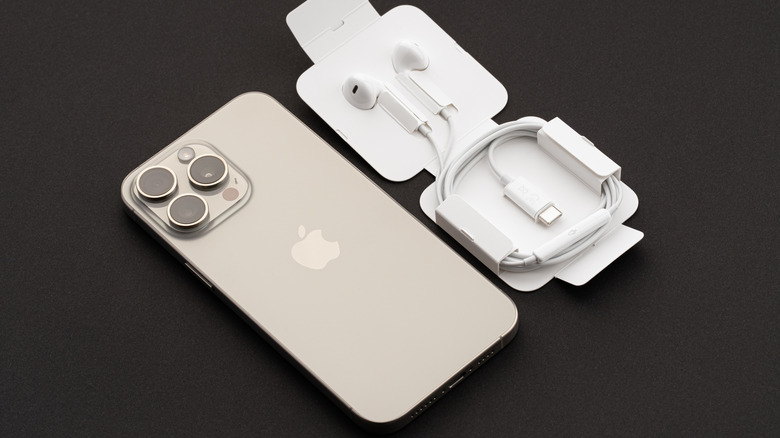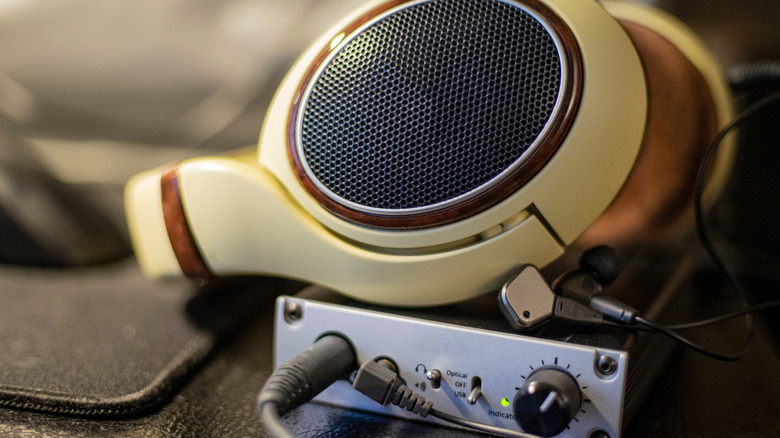Are USB Port Headphones Better For Audiophiles?
How a pair of headphones connects to your various devices is important: Especially in today's world where so few smartphones have headphone jacks, and many accessories connect using USB anyway. A vast majority of wired headphones connect to their sources using an analog jack (typically in the 3.5-millimeter or quarter-inch format), which makes them pretty "plug and play" for most listeners.
Then there are the headphones that connect using a USB port. While analog jacks are fairly simple, headphones that use USB as their output can be a little more complicated than that. The most basic version is probably something like the USB-C earbuds that Apple used to include in iPhone boxes when there was backlash over losing the 3.5-millimeter jack. These headphones are quite simple and use USB-C merely as their connection point, much like a headphone output. Therefore, the answer here is that they'll sound largely the same as the same pair of earbuds with a 3.5-millimeter output.
If you're considering a headset or a pair of active headphones that connect via USB, the decision can be a little more complicated. In general, the best headphones do still use analog outputs, especially in the audiophile space. However, many gaming headsets connect via USB because they contain their own audio drivers and digital-to-analog converters. But is a USB headset better than a 3.5-millimeter one for audiophiles? The simplest answer is "no, not typically," but we'll get into why that is in the next couple sections.
Compatibility and what your headphone connection means
To understand what the connection point means for your headphones, it's important to understand how it actually works. Fundamentally, USB supports a digital signal path, whereas a 3.5-millimeter jack supports an analog signal. Traditionally, this means that an amplified output will be sent to a 3.5-millimeter jack and your headphones can receive it as is, no processing needed. If you want that same signal to be sent via USB, there needs to be some level of conversion, turning that analog signal into a digital signal (abbreviated as DAC). This conversion can have an effect on the perceived sound, depending on the quality of the converter.
Because 3.5-millimeter jacks don't require that conversion, they are quite universal. If you have a pair of headphones like this, then nearly all legacy audio devices and modern computers will support the output, giving you universal compatibility. On the other hand, if you're looking at a USB headset to use with your computer, then you need to make sure that your computer can support the software needed for its use. That's because your computer will read your headphones as their own separate audio device or sound card. This also means that the headphones will have audio processing baked in.
Digital audio converters and digital signal processing
So far, we hope it's clear that the connection itself does not affect a headphones' sound, but rather when/how the analog signal is converted to/from a digital one. For simplicity's sake, the nod goes to 3.5-millimeter headphones, largely because they are compatible with a lot of analog-output devices right out of the box. But what about DAC? The reason most true audiophile headphones are connected using an analog jack is because they have been tuned to handle a high-quality analog signal, often delivered by headphone amps.
Most of the time, USB headsets use driver software and an on-board digital conversion chip to deliver sound. If it's a cheap headset, then this conversion is likely going to result in less-than-desirable artifacts. Some higher-end gaming headsets feature higher-quality conversion and digital signal processing like EQ and volume adjustments, which can sound better. While in most cases, analog headphones typically result in more reliable analog sound, USB headsets can provide some software features that may be beneficial.
One closing note on this topic is to consider your source device. If you're listening on an old-school music player or plugging into an analog amplifier, then the 3.5-millimeter headphones are simple and effective because there's no digital conversion necessary. If you're listening through a 3.5-millimeter jack on a computer, then it's important to remember that some digital-to-analog conversion is taking place on your computer's component level. This is why many audiophiles opt for high-end analog headphones and a high-quality desktop digital converter and amp combo: They can maximize the quality of their sound and deliver to their analog headphones with the right level of richness and nuance.


